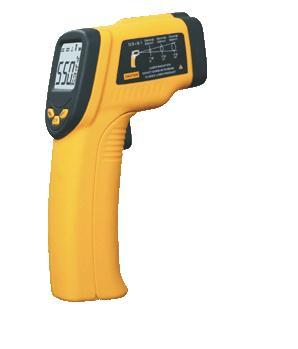 It is understood that the working principle of the infrared thermometer is mainly focused on the infrared detector on the photodetector, and then the energy is converted into a corresponding electrical signal. The signal passes through the amplifier and the signal processing circuit, and is converted into the temperature value of the measured target according to the algorithm of the internal therapy of the instrument and the target emissivity, so as to achieve the need of temperature measurement.
It is understood that the working principle of the infrared thermometer is mainly focused on the infrared detector on the photodetector, and then the energy is converted into a corresponding electrical signal. The signal passes through the amplifier and the signal processing circuit, and is converted into the temperature value of the measured target according to the algorithm of the internal therapy of the instrument and the target emissivity, so as to achieve the need of temperature measurement. In nature, all objects above absolute zero emit infrared radiation energy to the surrounding space. The size of the infrared radiation energy of an object and its distribution by wavelength have a very close relationship with its surface temperature. Therefore, by measuring the infrared energy radiated by the object itself, it can accurately determine its surface temperature, which is the objective basis for infrared radiation temperature measurement. Blackbody is an idealized radiator that absorbs all wavelengths of radiant energy, no energy is reflected and transmitted, and its surface has an emissivity of 1. However, the actual objects existing in nature are hardly black, and in order to understand and obtain the distribution of infrared radiation, a suitable model must be selected in the theoretical study. This is Planck's quantum oscillator model of body cavity radiation. Derived Planck's law of blackbody radiation, which is the wavelength of the blackbody spectrum of radiation, which is the starting point of all infrared radiation theory, it is called the black body radiation law. The radiation amount of all actual objects depends on the wavelength of the radiation and the temperature of the object, and also relates to the types of materials constituting the object, the preparation method, the thermal process, and the surface state and environmental conditions. Therefore, in order for the law of blackbody radiation to apply to all real objects, a proportional coefficient, namely the emissivity, must be introduced in relation to the properties of the material and the surface state. This coefficient represents the degree of closeness of the thermal radiation of the actual object to blackbody radiation, with values ​​between zero and a value less than one. According to the law of radiation, as long as the emissivity of the material is known, the infrared radiation characteristics of any object are known. The main factors that affect the emissivity are: material type, surface roughness, physical and chemical structure, and material thickness.
When measuring the target temperature with an infrared radiation thermometer, the infrared radiation amount of the target in its band is first measured, and then the temperature of the measured target is calculated by the thermometer. The monochromatic thermometer is proportional to the amount of radiation in the band; the dual pyrometer is proportional to the ratio of the radiation in both bands.
Ammonium dihydrogen phosphate (NH4H2PO4) is a white crystalline solid that is soluble in water. It is commonly used as a fertilizer, flame retardant, and food additive. It is also used in the production of ceramics, pharmaceuticals, and detergents. Ammonium dihydrogen phosphate is a source of both nitrogen and phosphorus, two essential nutrients for plant growth. It is often used in combination with other fertilizers to provide a balanced nutrient supply to crops. Ammonium dihydrogen phosphate is also used as a flame retardant in plastics and textiles, as it releases ammonia when heated, which dilutes the combustible gases and inhibits combustion. In the food industry, it is used as a leavening agent in baking powders and as a pH regulator in soft drinks.
Ammonium dihydrogen phosphate (ADP) is a colorless, crystalline compound with the chemical formula NH4H2PO4. It is commonly used as a fertilizer and as a food additive. ADP is also used in the manufacturing of ceramics, electronics, and other products.
ADP is soluble in water and has a slightly acidic pH. It is a highly reactive compound and can react with strong bases to form ammonium phosphate. ADP is also a source of phosphorus and nitrogen, which are essential nutrients for plant growth.
In addition to its use as a fertilizer, ADP is used in the production of ammonium polyphosphate, which is used as a flame retardant and in the manufacturing of plastics. ADP is also used in the production of specialty glasses and in the preparation of buffer solutions for laboratory use.
ADP has been classified as a hazardous substance by the United States Environmental Protection Agency due to its potential to cause harm to human health and the environment. It can cause skin and eye irritation, and inhalation of the dust can cause respiratory problems. ADP can also contribute to eutrophication, which is the excessive growth of algae in water bodies, leading to oxygen depletion and harm to aquatic life.
eavening agent
Sichuan Jinhe Qihang Co,. Ltd. , https://www.jinhechemicals.com